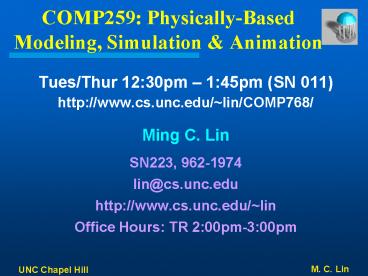COMP259: Physically-Based Modeling, Simulation - PowerPoint PPT Presentation
Title:
COMP259: Physically-Based Modeling, Simulation
Description:
Title: 3D Polyhedral Morphing Author: glab Last modified by: dm Created Date: 3/12/1998 6:53:32 PM Document presentation format: On-screen Show Company – PowerPoint PPT presentation
Number of Views:45
Avg rating:3.0/5.0
Title: COMP259: Physically-Based Modeling, Simulation
1
COMP259 Physically-Based Modeling, Simulation
Animation
- Tues/Thur 1230pm 145pm (SN 011)
- http//www.cs.unc.edu/lin/COMP768/
- Ming C. Lin
- SN223, 962-1974
- lin_at_cs.unc.edu
- http//www.cs.unc.edu/lin
- Office Hours TR 200pm-300pm
2
Prerequisities
- Old COMP250 (Scientific Computing)
- or
- old Math 191 (ODEs)
- Old COMP235 (Images, Graphics Vision) or
- old COMP136 (Elementary 3D Graphics)
3
Textbook References
- SIGGRAPH course notes
- In-class handouts
- Other research papers
- More references (books, papers, pointers to other
interesting resources) available at the course
website
4
Course Overview
- 3D Models Images -gt Rendering
- (old COMP 236 238)
- Virtual Reality Interface (old COMP239)
- Geometric Solid Modeling (old COMP 258)
- This course focuses on
- MOVEMENTS making them move !
5
What Will We Be Doing
- Geometry
- Collision Detection
- Computing Contact Manifolds
- Mechanics
- Particle Dynamics
- Rigid Body Dynamics
- Non-Rigid Body Dynamics
- Fluid Dynamics
- Numerical Computing
- Initial Value Problems
- Boundary Value Problems
- Constraints Differential-Algebraic Equations
6
Possible Applications
- Computer Animation
- Virtual Environments
- Rapid Prototyping
- Haptic Rendering
- Computer Game Dynamics
- Robotics and Automation
- Medical Simulation and Analysis
7
Goals
- Be aware with a collection of geometric
algorithms for modeling contacts. - Be knowledgeable with the following numerical
methods for simulation initial value problems,
constrained optimization, differential-algebraic
equations, boundary value problems, etc - Be familiar with the following modeling paradigms
of physical and biological systems particle
dynamics, rigid body dynamics, flexible and
deformable bodies - Be able to analyze the correctness and runtime
performance of a given simulation method. - Be able to apply some techniques to research
problems.
8
See Course Website
- http//www.cs.unc.edu/lin/COMP768
- for more details































